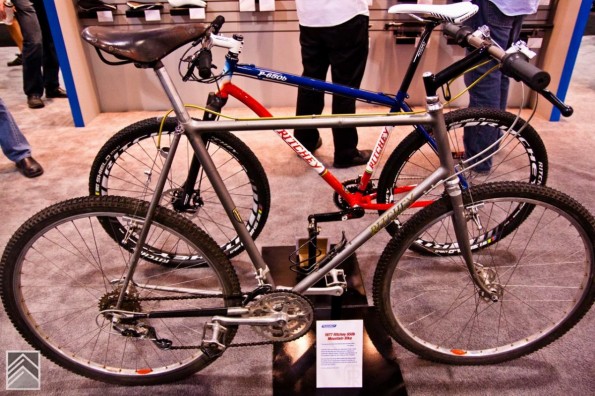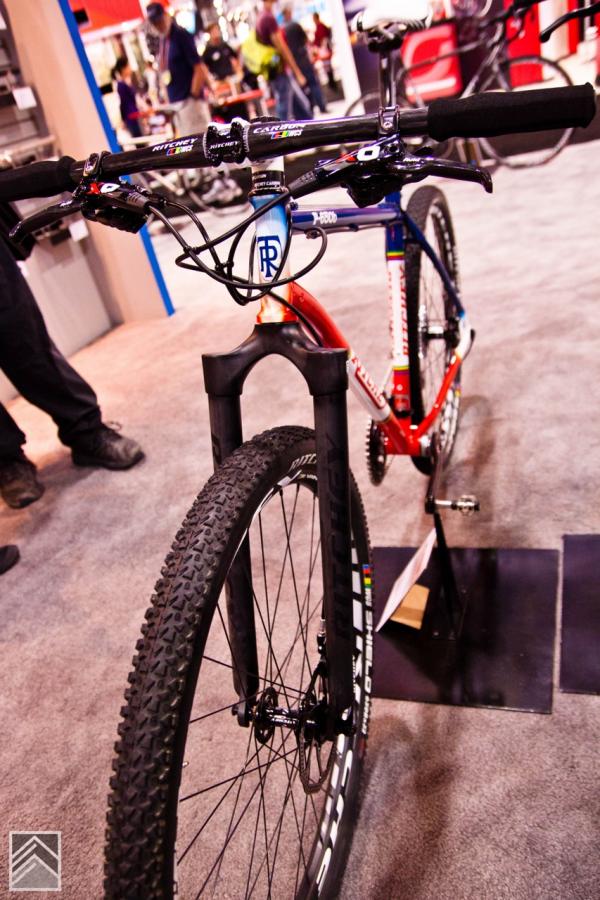Click here to read “The 650b (R)evolution, Part 1: Jamis, KHS, and Tires.”
The Godfather of 650b Mountain Bikes: Tom Ritchey
While most of what we’ve been writing here on Singletracks refers to 650b as a new mountain bike trend, if you look at the history of the sport this wheel standard is anything but new. We stopped by the Ritchey booth at Interbike and spotted a 650b Ritchey from the 70’s standing right next to Ritchey’s newest 650b hardtail wonder bike:


According to the rep we spoke with, the silver bike pictured above is one of the first mountain bikes ever built from the ground up… and it sports 650b wheels! 650b tires were the ones available with the most aggressive tread patterns at the time, so Ritchey built this bike around the 650b wheel size. He wanted to continue making 650b bikes but, according to legend, the Soviet Union bought up all of the 650b tires and wheels, so none were available. As a result, mountain bike builders had to resort to using 26″ wheels and tires that were available for cruiser bikes. No word on why the Soviet Union bought up all the tires and wheels to begin with, and it’s unclear how much of this is fact and how much is urban legend, but if the Cold War is responsible for the long-time dominance of the 26″ wheel in the mountain bike world, well that’s pretty crazy!
The rep we spoke with also mentioned a characteristic of 650b wheels that I hadn’t been aware of before: the bottom to top height of a 650b wheel + tire is often equal to that of a 700c road wheel + tire:

For riders coming from a background in road cycling, the rep claimed that riding 650b wheel feels much more natural because they already know how the wheel size handles, so it helps ease the transition. Now, I’m not sure how much of a difference that really makes, since even a mountain bike with 650b wheels will handle radically different than a road bike due to its unique geometry, altered cockpit, etc. Also, I’m sure the bottom to top height also depends on the tire: some mountain bike tires have a much taller profile than others.
While some parts of these legends may or may not be true, I found my interview at the Ritchey booth an enlightening experience!
The (R)evolution: Are 650b Bikes Actually Selling?
While the push for 29er mountain bikes seemed to be a very organic, consumer-driven movement, the production of 650b bikes seems to be radically different, in that it is more of a top-down movement with the bike companies leading the way. Sure, there have always been some 650b diehards out there, but the demand for the tweener wheel doesn’t seem to be widespread. Also, it’s worth noting that this isn’t a true top-down push, as the big three (Giant, Specialized, and Trek) haven’t jumped on the band wagon yet.
So how the heck are we supposed to look at this trend: Is it a natural evolution of mountain bike technology, or is it an organized coup against the 26-inch wheel? Will the 650b wheel mount a gradual take over, slowly eliminating the 26″ wheel from Asian assembly lines, or will dumpsters be immediately filled with 26″ wheeled products that have no hope of ever selling?
Here at Singletracks we’ve been a little skeptical about whether or not 650b bikes are actually selling. When I was on the road this summer, I was looking for some new 650b tires as I had torn the sidewall on my test rig’s rear tire. Thankfully I was able to hold it together with tube patches, as not a single shop that I walked into from Moab, Utah to Los Angeles, California (and everywhere in between) had 650b tires in stock. While some of the salesmen and mechanics that I talked to claimed they were tossing around the idea of stocking 650b tires and bikes, how much of that is just talk based on the hyped-up marketing machine?
To try to get some answers to this question, Jeff did a little asking around at the show. Here are some of his findings and thoughts:
One of the questions I asked a number of folks at Interbike is whether they’re seeing actual orders for 650b bikes and/or components. The tire people say heck yeah, we can’t make ‘em fast enough! But those tires are going OEM; that doesn’t mean anyone is actually buying the bikes these tires are attached to (yet). Shop/consumer purchases are a bit murkier–no one could confirm whether there was real consumer demand for 650b yet … Until real buyers (retailers, then consumers) start asking for these bikes and components, 650b will remain “coming soon.”
So what do you think? Is this an evolution, or a revolution? And when will riders actually start buying 650b products?
Stay tuned for Part 3 of “The 650b (R)evolution.“



















